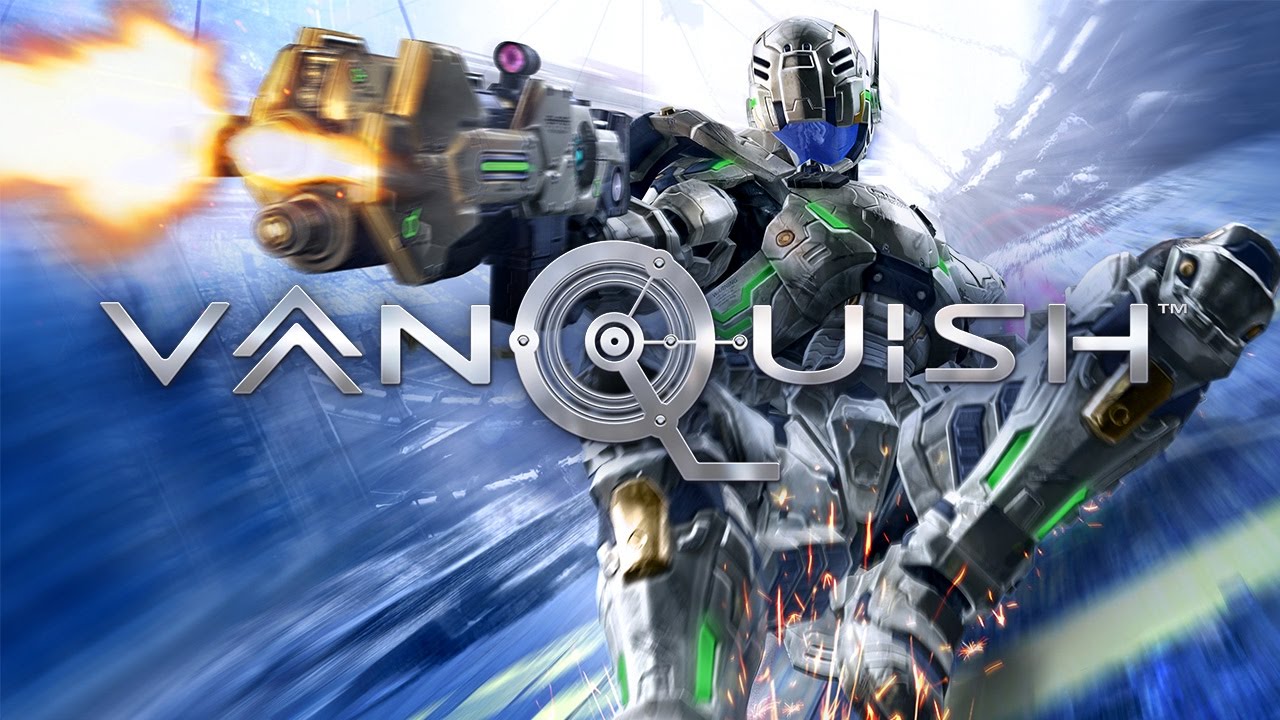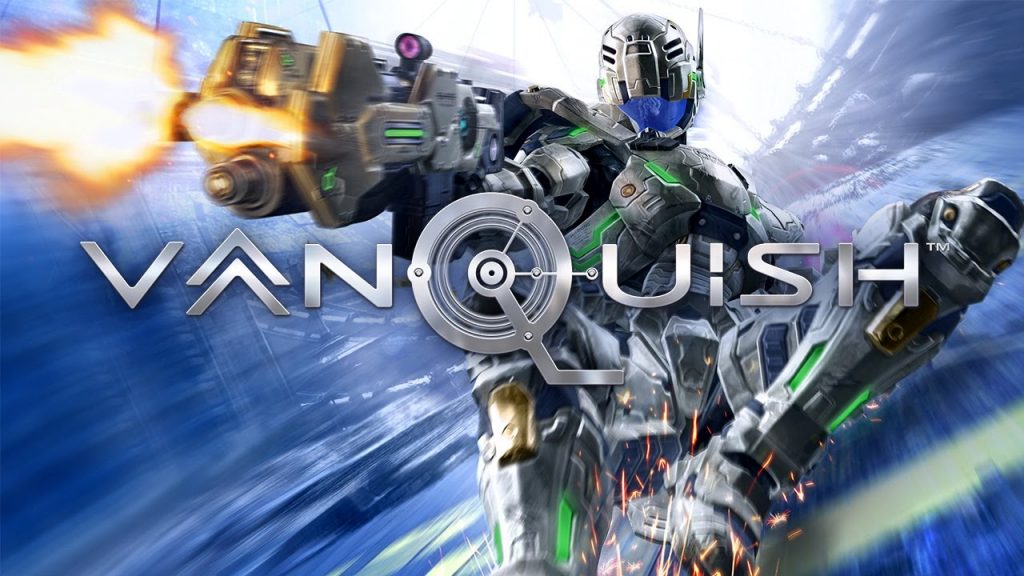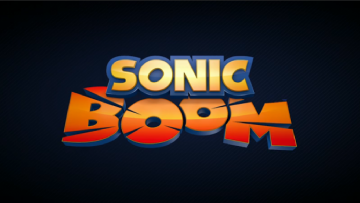
Review: Vanquish (PlayStation 4)
When Vanquish came out, the narrative (as I understood) was that the game had been dealt a raw deal. Vanquish was Platinum’s attempt at making a third person cover shooter, and the problem was that you absolutely are not supposed to play Vanquish like that. You can, if you really want to, but all that does is make Vanquish into a tedious grind, as encounters are designed with the game’s mobility in mind. Some people did not get the memo, and Vanquish struggled to gain traction back in 2010. Since then, it’s become an underdog favorite among Platinum’s fans. Seeing as this was my first time playing Vanquish, I can confirm that at least part of the above story is true.
If you are sitting still in Vanquish, you’re not playing it correctly. This is essentially a cover shooter like Gears of War, but combined with the boost meter from Sonic Generations. Combat arenas aren’t just full of convenient, waist-high hiding spots, they’re also massive and often laid out more like racing circuits, with huge numbers of enemies coming in from all directions. Cover exists for one reason: as a place to stop and catch your breath while your boost meter recharges. With your jets sufficiently cooled, it’s off to the races once again, boosting around the arena, putting holes in whatever is unlucky enough to cross your path.

Confusion about how to play could have been avoided if Vanquish had a better tutorial. After running through some basic camera configuration, most of the information on how to play the game is presented as optional. But even if you go through the trouble of learning everything that’s available to you, it only really explains the game’s controls — the biggest failure in Vanquish is in communicating context for any of your abilities. It tells you HOW to boost, but it never tells you WHY you’d NEED to boost. You’re expected to figure that out on your own.
In Bayonetta, punching and kicking is central to what you do in that game, and every loading screen gives you a list of moves to try out, telling you which mixture of attacks will trigger a combo. Vanquish never does that; it tells you to move your arms and legs, and figures that’s enough information to swim in the deep end of the pool. While it’s refreshing to have a game trust the player to learn to play on their own terms, it’s easy to misunderstand how Vanquish is meant to be played, and the game never cracks the whip hard enough on what the “correct way” actually is.
The good news is, if you’re reading this, you should be better prepared to enjoy Vanquish. Going in to the game knowing I might have to do some extra digging in order to fill in the blanks was all I needed to know, and soon, I was boosting and back flipping my way around 50 foot tall robots like a pro — though I’d be lying if there wasn’t a little voice in the back of my head still wondering if I was playing the game “right” or not. I suppose that’s the ultimate lesson, here: as long as you’re having fun, how you play the game doesn’t matter, and Platinum gives you a long leash to experiment with. Maybe a bit too long, some might say.
When Vanquish came out, the narrative (as I understood) was that the game had been dealt a raw deal. Vanquish was Platinum’s attempt at making a third person cover shooter, and the problem was that you absolutely are not supposed to play Vanquish like that. You can, if you really want to, but all that does is make Vanquish into a tedious grind, as encounters are designed with the game’s mobility in mind. Some people did not get the memo, and Vanquish struggled to gain traction back in 2010. Since then, it’s become an underdog favorite among Platinum’s fans. Seeing as this was my first time playing Vanquish, I can confirm that at least part of the above story is true.
If you are sitting still in Vanquish, you’re not playing it correctly. This is essentially a cover shooter like Gears of War, but combined with the boost meter from Sonic Generations. Combat arenas aren’t just full of convenient, waist-high hiding spots, they’re also massive and often laid out more like racing circuits, with huge numbers of enemies coming in from all directions. Cover exists for one reason: as a place to stop and catch your breath while your boost meter recharges. With your jets sufficiently cooled, it’s off to the races once again, boosting around the arena, putting holes in whatever is unlucky enough to cross your path.
Confusion about how to play could have been avoided if Vanquish had a better tutorial. After running through some basic camera configuration, most of the information on how to play the game is presented as optional. But even if you go through the trouble of learning everything that’s available to you, it only really explains the game’s controls — the biggest failure in Vanquish is in communicating context for any of your abilities. It tells you HOW to boost, but it never tells you WHY you’d NEED to boost. You’re expected to figure that out on your own.
In Bayonetta, punching and kicking is central to what you do in that game, and every loading screen gives you a list of moves to try out, telling you which mixture of attacks will trigger a combo. Vanquish never does that; it tells you to move your arms and legs, and figures that’s enough information to swim in the deep end of the pool. While it’s refreshing to have a game trust the player to learn to play on their own terms, it’s easy to misunderstand how Vanquish is meant to be played, and the game never cracks the whip hard enough on what the “correct way” actually is.
The good news is, if you’re reading this, you should be better prepared to enjoy Vanquish. Going in to the game knowing I might have to do some extra digging in order to fill in the blanks was all I needed to know, and soon, I was boosting and back flipping my way around 50 foot tall robots like a pro — though I’d be lying if there wasn’t a little voice in the back of my head still wondering if I was playing the game “right” or not. I suppose that’s the ultimate lesson, here: as long as you’re having fun, how you play the game doesn’t matter, and Platinum gives you a long leash to experiment with. Maybe a bit too long, some might say.
Aesthetically, Vanquish is cut from the same cloth that would later come to define Platinum’s Metal Gear Rising: Revengeance. This is a distant future where technology is borderlining on magic — microwave lasers cook entire cities in the opening cinematic, characters have cybernetic limbs, the military is stationed in space, and robot armies are endless in their number. It’s all filtered through the lens of Japan’s take on American action movies. It’s Paul Verhoeven’s Starship Troopers, it’s Halo, it’s obviously Gears of War. Absolutely none of it is serious. Dialog is beyond over the top, in voices that sound like they’re trying too hard to be gruff (on purpose, mind you). The character you play as, Gideon, has a dedicated button to smoke a cigarette while in cover. Your commanding officer chugs whiskey if left alone long enough. You increase your weapon’s military rank by hoarding more of that same gun. It’s a deeply stupid game, but in the best possible way.
Both Vanquish and Bayonetta are being presented on PlayStation 4 for the first time as part of a “10th Anniversary Bundle.” Wording is vague, but it’s implied both games have been remastered in 4K for the platform. When it came to Bayonetta, I found that game to be pretty much identical to the PC version in terms of image quality and framerate. You can still make Bayonetta on the PC look a little nicer than the PS4 version by using MSAA to soften polygon edges, but it’s a minor thing at best. Bayonetta looks fantastic regardless of which modern version you’re playing.
The same cannot be said of Vanquish. It’s a more graphically sophisticated game than Bayonetta was in 2009, with high-resolution detail textures and tons of dynamic shadows. The original console version struggled to hit even 30fps back in the day, and while even a modest PC today can handle Vanquish no problem, the Playstation 4 seems to inherit some of the problems present in the original 2010 console version. I assume the problem stems from Sega’s claim that this version hits 4K 60fps — that’s a tall order for any game to reach, and for Vanquish, hitting that resolution and that framerate comes at a cost.
The biggest issue is shadow resolution. Vanquish on Playstation 4 seems to be using the PC version’s “low” setting. In some cases, it actually looks worse than the original 2010 console version, with jagged, blocky shadows shimmering across characters and environments. Similarly, the PC version offers the ability to increase distant detail, an option that is also disabled on PlayStation 4 version. Objects that are far enough away from the player are simplified and will “pop” in to a higher-detail version once they get closer. Things like this were likely done to ensure Vanquish maintains the advertised 4K 60fps gameplay, but it hurts the overall visual presentation. These also aren’t the only technical problems present in this port — I occasionally experienced flickering textures, crackling audio, and the game even crashed at a checkpoint, corrupting my save file and making me restart over from the beginning (since then, the game has received at least one patch, but it did nothing for the visuals).
Vanquish is a game I want to recommend, but to do so would require many qualifiers. For starters, if you’ve got capable hardware, you’ll get the best experience on the PC. Ignoring one-off save game corruption I experienced, the visual problems with the PlayStation 4 version aren’t necessarily deal breakers, just unfortunate. And then there’s the gameplay. Vanquish is a very fun game to play — but it doesn’t make it obvious where that fun is. Platinum has built a culture where games like Bayonetta deduct points and lower ratings for using healing items. You are meant to be strong enough to finish a Platinum game through your own skill alone, but this is an idea that Vanquish struggles with. The best way to enjoy Vanquish is after looking at someone else’s guide on how to play the game, betraying Platinum’s mantra.
It makes for a slightly wobbly port of a slightly wobbly game. Vanquish is still worth experiencing at least once, but there is definitely a lot of room for improvement here.
Review code provided by SEGA. This post was originally written for TSSZ News.
Aesthetically, Vanquish is cut from the same cloth that would later come to define Platinum’s Metal Gear Rising: Revengeance. This is a distant future where technology is borderlining on magic — microwave lasers cook entire cities in the opening cinematic, characters have cybernetic limbs, the military is stationed in space, and robot armies are endless in their number. It’s all filtered through the lens of Japan’s take on American action movies. It’s Paul Verhoeven’s Starship Troopers, it’s Halo, it’s obviously Gears of War. Absolutely none of it is serious. Dialog is beyond over the top, in voices that sound like they’re trying too hard to be gruff (on purpose, mind you). The character you play as, Gideon, has a dedicated button to smoke a cigarette while in cover. Your commanding officer chugs whiskey if left alone long enough. You increase your weapon’s military rank by hoarding more of that same gun. It’s a deeply stupid game, but in the best possible way.
Both Vanquish and Bayonetta are being presented on Playstation 4 for the first time as part of a “10th Anniversary Bundle.” (you can read our review of Bayonetta here) Wording is vague, but it’s implied both games have been remastered in 4K for the platform. When it came to Bayonetta, I found that game to be pretty much identical to the PC version in terms of image quality and framerate. You can still make Bayonetta on the PC look a little nicer than the PS4 version by using MSAA to soften polygon edges, but it’s a minor thing at best. Bayonetta looks fantastic regardless of which modern version you’re playing.
The same cannot be said of Vanquish. It’s a more graphically sophisticated game than Bayonetta was in 2009, with high-resolution detail textures and tons of dynamic shadows. The original console version struggled to hit even 30fps back in the day, and while even a modest PC today can handle Vanquish no problem, the Playstation 4 seems to inherit some of the problems present in the original 2010 console version. I assume the problem stems from Sega’s claim that this version hits 4K 60fps — that’s a tall order for any game to reach, and for Vanquish, hitting that resolution and that framerate comes at a cost.
The biggest issue is shadow resolution. Vanquish on Playstation 4 seems to be using the PC version’s “low” setting. In some cases, it actually looks worse than the original 2010 console version, with jagged, blocky shadows shimmering across characters and environments. Similarly, the PC version offers the ability to increase distant detail, an option that is also disabled on PlayStation 4 version. Objects that are far enough away from the player are simplified and will “pop” in to a higher-detail version once they get closer. Things like this were likely done to ensure Vanquish maintains the advertised 4K 60fps gameplay, but it hurts the overall visual presentation. These also aren’t the only technical problems present in this port — I occasionally experienced flickering textures, crackling audio, and the game even crashed at a checkpoint, corrupting my save file and making me restart over from the beginning (since then, the game has received at least one patch, but it did nothing for the visuals).
Vanquish is a game I want to recommend, but to do so would require many qualifiers. For starters, if you’ve got capable hardware, you’ll get the best experience on the PC. Ignoring one-off save game corruption I experienced, the visual problems with the PlayStation 4 version aren’t necessarily deal breakers, just unfortunate. And then there’s the gameplay. Vanquish is a very fun game to play — but it doesn’t make it obvious where that fun is. Platinum has built a culture where games like Bayonetta deduct points and lower ratings for using healing items. You are meant to be strong enough to finish a Platinum game through your own skill alone, but this is an idea that Vanquish struggles with. The best way to enjoy Vanquish is after looking at someone else’s guide on how to play the game, betraying Platinum’s mantra.
It makes for a slightly wobbly port of a slightly wobbly game. Vanquish is still worth experiencing at least once, but there is definitely a lot of room for improvement here.
Review code provided by SEGA. This post was originally written for TSSZ News.



![[ID: Zy3uIbMRXK8] Youtube Automatic](https://lastminutecontinue.com/wp-content/uploads/2024/04/id-zy3uibmrxk8-youtube-automatic-360x203.jpg)


